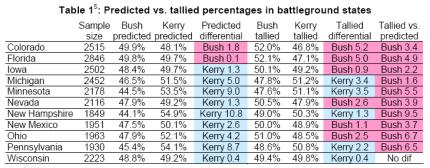The Unexplained Exit Poll Discrepancy: Part I
Center for Organizational Dynamics
Working Paper #04-10 November 21, 2004
Note on this revision: - The thesis of the initial drafts of this paper that were widely circulated on the Internet, was that exit poll discrepancy could not have been due to chance or random error. My purpose was to raise as a legitimate question, “What caused it?” In this version, I begin to try to answer that question.
I’m releasing this paper in two parts, so as to replace the early drafts as soon as possible. Part I is to clean up the previous draft. Part II will be new analysis.
Reading note: To help non-academic readers, I have put in much more explanatory material than typical –, especially in the statistical analysis sections (also a glossary in Appendix B). My apologies to those for whom these explanations are superfluous. Just skip over those sections.
The Unexplained Exit Poll Discrepancy: Part I
Steven F. Freeman, PhD stfreema@sas.upenn.eduREAD THE FULL PAPER HERE (Adobe .pdf format): http://www.scoop.co.nz/stories/pdfs/Exitpoll_discrep_v00p1_Part_I.pdf
Most Americans who had listened to radio or surfed the Internet on Election Day this year, sat down to watch election night coverage expecting that John Kerry had been elected President. Exit polls showed him ahead in nearly every battleground state, in many cases by sizable margins. Although pre-election day polls indicated the race dead even or Bush slightly ahead, two factors seemed to explain Kerry’s edge: turnout was extraordinary high, which is generally good for Democrats,1 and as in every US Presidential election with an incumbent over the past quartercentury, 2 undecided voters broke heavily toward the challenger.
But then, in key state after key state, counts showed very different numbers than the polls predicted; and the differentials were all in the same direction. The first shaded column in Table 1 shows the differential between the major candidates’ predicted (exit poll) percentages of the vote; the next shaded column shows the differential between their tallied percentages of the vote. The final shaded column reveals the “shift.” In ten of the eleven consensus battleground states,4 the tallied margin differs from the predicted margin, and in every one, the shift favors Bush.

Click for big version
The media has largely ignored this discrepancy (although the Blogosphere has been abuzz), suggesting that the polls were either flawed, within normal sampling error, a statistical anomaly, or could otherwise be easily explained away. In Part I of this paper, I examine the validity of exit polls, the likelihood of sampling error, and the possibility of statistical anomaly and show that the exit poll discrepancy could not have been due to chance or random error. In Part II, I explore the explanations for what did cause it, and speculate on the big question on readers’ minds, what this data can tell us about whether the count was correct.
READ THE FULL PAPER HERE (Adobe .pdf format): http://www.scoop.co.nz/stories/pdfs/Exitpoll_discrep_v00p1_Part_I.pdf
ENDS


 Binoy Kampmark: Fallibility, Dirty Wars And Pope Francis I
Binoy Kampmark: Fallibility, Dirty Wars And Pope Francis I Peter Dunne: Dunne's Weekly - An Issue No-one Can Afford To Lose
Peter Dunne: Dunne's Weekly - An Issue No-one Can Afford To Lose Martin LeFevre - Meditations: Choosing Mass Murder?
Martin LeFevre - Meditations: Choosing Mass Murder? Eugene Doyle: Quiet Mutiny - The U.S. Army Falls Apart
Eugene Doyle: Quiet Mutiny - The U.S. Army Falls Apart Gordon Campbell: Papal Picks, And India As A Defence Ally
Gordon Campbell: Papal Picks, And India As A Defence Ally Binoy Kampmark: The Selling Of America - Ending The US Dollar’s Exorbitant Privilege
Binoy Kampmark: The Selling Of America - Ending The US Dollar’s Exorbitant Privilege